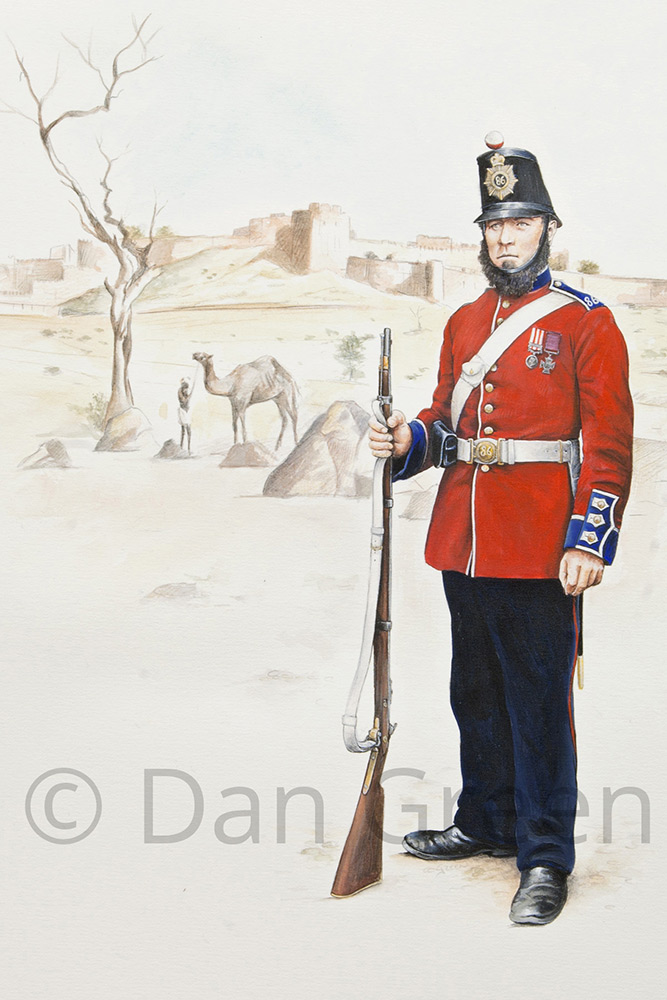James Byrne VC (1822-1872)
86th (Royal County Down) Regiment of Foot
Jhansi, Central India, 1858

James Byrne VC
(1822-1872)
86th (Royal County Down) Regiment of Foot
Jhansi, Central India, 1858



86th (Royal County Down) Regiment of Foot
Jhansi, Central India, 1858
Prints Available – Original Sold
I decided to show Byrne in full dress without pack and water bottle wearing his medals – the VC and the Indian Mutiny medal with clasp ‘Central India’.
James Byrne (1822-1872)
Born: 1822, Newtownmountkennedy, County Wicklow, Eire
Died: 6th December, 1872, Dublin, Eire
Born at Newtownmountkennedy, a small town in County Wicklow, south of Dublin in 1822. He died on the 6th December 1872 in Dublin and is buried in Glasnevin Cemetery.
Byrne was awarded the Victoria Cross in 1858, for the action at Jhansi, India. The citation in the London Gazette of the 11th November 1859 reads:
‘For gallant conduct on the 3rd of April, 1858, at the attack of the Fort of Jhansi, in carrying Lieutenant Sewell, who was lying badly wounded, to a place of safety, under a very heavy fire, assisted by Captain Jerome, in the performance of which act he was wounded by a sword cut.’
His VC is held in the Royal Ulster Rifles Museum in Belfast.
The Regimental History recorded the following:
“The storming of the fortress was ordered for the morning of 3 April. The main attack was directed on the breach where the city walls met on the high mound on the southern face of the Fort. The stormers were led by Lieutenant Jerome of The Royal County Down. Simultaneously, an escalading party of the County Down, with a party of Bombay Native Infantry, was directed on the wall.
The breach was forced with comparative ease and the Grenadier Company of The Royal County Down secured the mound. The Light Company led the escalade assault force and approached the wall just before daybreak. When near it, Major Stuart of The Royal County Down, who was leading, called out: ‘Now lads. For an Irish yell.’ And an officer reported: ‘Such a yell was given as might have frightened the Devil.’ The assault came under terrible fire, of stinkpots, rockets, and red hot balls, which were to be numbered among the drawbacks of siege operations. There were many casualties but the ladders were planted (by Royal Engineers).
There followed a bitter struggle to obtain a footing on the wall. However, a space was cleared on the top of the wall and the breach party, under Lieutenant Jerome, meanwhile took the enemy in flank. The rebels withdrew to the cover of fortified houses from which they brought a heavy fire to bear. They were followed by the infuriated Irishmen, who winkled them out of the houses. The County Downs now came under severe fire from the Fort so fell back, with heavy losses.
Ensign Sewell was badly hit but Lieutenant Jerome and Private Byrne carried him off at the risk of their own lives. They were both subsequently awarded the Victoria Cross, Lieutenant Jerome being promoted to the brevet of major and Private Byrne in due course attaining the rank of sergeant.
Prints Available – Original Sold
James Byrne VC (1822-1872)
Born: 1822, Newtownmountkennedy, County Wicklow, Eire
Died: 6th December, 1872, Dublin, Eire
Born at Newtownmountkennedy, a small town in County Wicklow, south of Dublin in 1822. He died on the 6th December 1872 in Dublin and is buried in Glasnevin Cemetery.
Byrne was awarded the Victoria Cross in 1858, for the action at Jhansi, India. The citation in the London Gazette of the 11th November 1859 reads:
‘For gallant conduct on the 3rd of April, 1858, at the attack of the Fort of Jhansi, in carrying Lieutenant Sewell, who was lying badly wounded, to a place of safety, under a very heavy fire, assisted by Captain Jerome, in the performance of which act he was wounded by a sword cut.’
His VC is held in the Royal Ulster Rifles Museum in Belfast.
The Regimental History recorded the following:
“The storming of the fortress was ordered for the morning of 3 April. The main attack was directed on the breach where the city walls met on the high mound on the southern face of the Fort. The stormers were led by Lieutenant Jerome of The Royal County Down. Simultaneously, an escalading party of the County Down, with a party of Bombay Native Infantry, was directed on the wall.
The breach was forced with comparative ease and the Grenadier Company of The Royal County Down secured the mound. The Light Company led the escalade assault force and approached the wall just before daybreak. When near it, Major Stuart of The Royal County Down, who was leading, called out: ‘Now lads. For an Irish yell.’ And an officer reported: ‘Such a yell was given as might have frightened the Devil.’ The assault came under terrible fire, of stinkpots, rockets, and red hot balls, which were to be numbered among the drawbacks of siege operations. There were many casualties but the ladders were planted (by Royal Engineers).
There followed a bitter struggle to obtain a footing on the wall. However, a space was cleared on the top of the wall and the breach party, under Lieutenant Jerome, meanwhile took the enemy in flank. The rebels withdrew to the cover of fortified houses from which they brought a heavy fire to bear. They were followed by the infuriated Irishmen, who winkled them out of the houses. The County Downs now came under severe fire from the Fort so fell back, with heavy losses.
Ensign Sewell was badly hit but Lieutenant Jerome and Private Byrne carried him off at the risk of their own lives. They were both subsequently awarded the Victoria Cross, Lieutenant Jerome being promoted to the brevet of major and Private Byrne in due course attaining the rank of sergeant.

